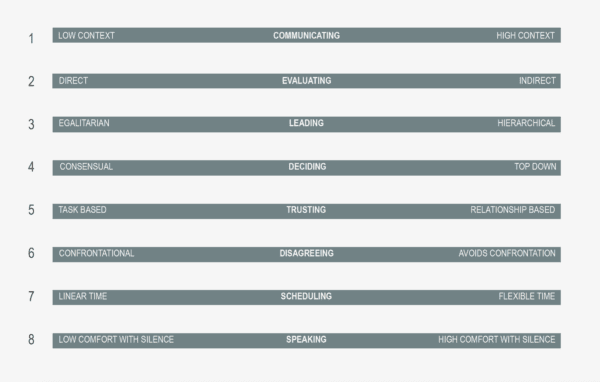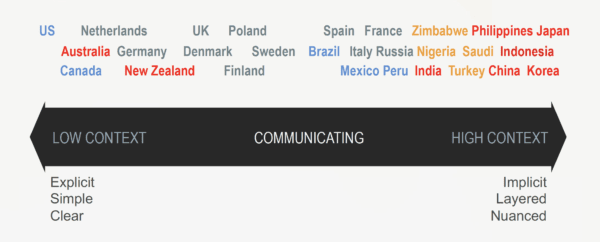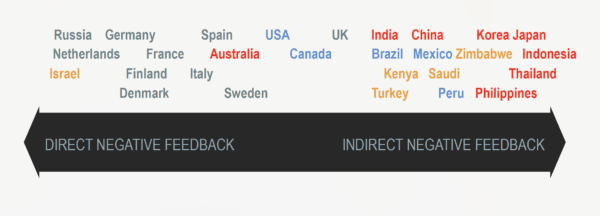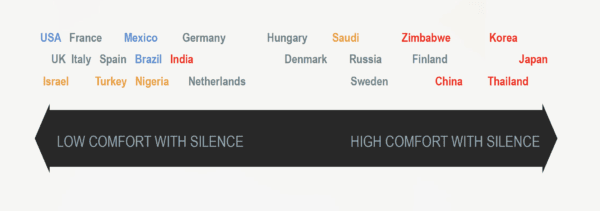5Oct2022
Globalization has become so much the norm over the last half-century that it can be easy to forget that doing business with people from a country at the other end of the world is, well, doing business with people from the other end of the world! Despite the use of common languages, concepts, and tools in business, there remain important cultural differences.
INSEAD Professor and author Erin Meyer has made a career out of studying these differences, mapping them out, and helping people understand how to navigate the inevitable tensions that pop up between them in a business setting.
Meyer’s focus at the Nordic Business Forum 2022 was using the concept of culture maps—a concept she pioneered in her 2014 book—to help people conduct business more effectively across cultures.
The Concept of a Culture Map
Culture mapping breaks down interpersonal behaviors into 8 scales, where cultures can be placed on a spectrum regarding how they tend to interact with others along different dimensions.

Thus far, Meyer and her colleagues have mapped out over 62 countries. While the maps can be very useful, she points out 2 things about her culture map project in general, and this talk in particular.
First, she notes that there is nuance and variance at work in the attributes of cultures. She explains that we can think of a country’s position on the culture map “as a midpoint of what would be considered acceptable behavior in one environment.”
She gives the example of negative feedback in Denmark. The range of acceptable directness and candor of negative feedback may veer more to one side for the Danes, but to the other side for people in the US—and even more so in Thailand. But there is overlap.
So a very Danish Dane may give very direct negative feedback, and that wouldn’t jibe with a very Thai individual, or someone on the far end of the U.S. range. But there are Danes near the far end of the range (toward indirect negative feedback) who could get by just fine with many folks in Thailand, and even more in the U.S.
Second, Meyer points out that the focus here is not on how particular people act. “We’re not talking about what individuals are like,” she says. “We’re talking about how a society perceives individual behavior.”
With that, Meyer jumps into 3 specific dimensions or scales of the culture map, to show both what it can tell us about other cultures, but also what it might help us do in order to close gaps and prevent misunderstandings.
Communicating
Meyer begins her deep dive by putting up the spectrum or scale on which cultures can fall for communicating. What’s at issue is how much context each culture expects or assumes prior to verbalizing things—as well as between and after verbalization. She refers to one end of the scale as “low context” and the other “high context”.

Low Context cultures assume little to no shared references. They tend to be very literal and explanatory in nature. Meyer notes that on the graph above, English-speaking countries tend to be on the Low Context end of the spectrum. This is because English is a very literal language.
Within that group, some cultures who speak English still manage to be higher context than others—as Meyer explains in the case of the UK vs. the US—where there’s more “inside lingo”, as it were.
High context cultures assume a lot of shared references and background. As an example, the word kal in Hindi means both “yesterday” and” today.” This means that we only understand what the person using it meant based on the context in which they used the word. Many Asian cultures tend to operate much like this.
Meyer also points out that the Japanese—who are the most high context communicators—even have a term for folks who they see as poor communicators. They call them “kuuki yomenai” or “someone who is unable to read the air.” Now that’s high context!
“Usually, when low context people work with high context people…they complain,” Meyer points out. “They say they’re lacking transparency, they’re hiding information, I feel like I don’t trust them.”
On the other hand, low context communicators are often seen as condescending, or at times, not so smart themselves.
- Meyer does give a few helpful tips for communicating across the spectrum of cultures more effectively:
- Multi-cultural teams benefit from low context processes.
- Be as explicit as possible with low context people. Put things in writing and repeat key points.
- With high context people, look more closely for unspoken meanings, and look for cultural bridges to help you ask clarifying questions—to help you “read the air”.
“If you set off the amygdala, you end up breaking the relationship. And then it’s hard to go back.”
Negative Feedback
Meyer moves from the nature of cultures’ communication as a whole to a more specific aspect of communication: giving negative feedback.
Some cultures give more direct negative feedback as a matter of course. Others are more indirect—seeming to leave it up to the recipient as to whether or not something needs to be done, rather than making it clear what needs to be changed.
Perhaps most interesting is where cultures fall on this map, as opposed to the communication map. The English-speaking countries fall squarely in the middle.

What we see coming out of this map, Meyer says, is people coming out of these cultures not only with different ways of giving negative feedback, but also with different ways of handling it.
Meyer cautions the audience to be particularly cautious about cultures on the right-hand side of this spectrum, but whose communication style is also high context. She gives an example of the contrast between Chinese culture—where it’s considered inappropriate to look someone in the eye and say “no”, as opposed to France, where “no” is often repeated emphatically at the outset, but tends to merely open the door for negotiation.
So what should we try to do in a global business setting? Meyer says that the answer lies in the structure of our brains. Our frontal cortex—where logic and reason happen—loves direct negative feedback. The amygdala—which is responsible for our more immediate and emotional “fight or flight” responses—perceives direct negative feedback as a threat. For this reason, Meyer cautions, global teams should aim a little more toward the right end of the spectrum: more indirect negative feedback.
Speaking
Meyer ends her talk by exploring the spectrum of how cultures tend to feel about and interpret silence in conversations. She displays a slide with a color-coded layout of where different cultures fall on this scale.

“Cultures on the left-hand side of the scale tend to interpret silence as something negative,” she tells the audience. “To a culture on the right-hand side, that silence may signify something positive—like that I’m listening carefully.”
Meyer points to 3 distinct styles or rhythms of conversation, based largely on the roots of that culture’s predominant language.
Latin linguistic cultures tend to allow and encourage overlap—with people talking over one another’s final words as a sign of enthusiasm and engagement.
Anglo-Saxon cultures tend to treat conversation more like table tennis—where interruption is not generally encouraged, but there is an expectation to immediately respond.
But in East-Asian cultures, silence between speakers is normal (as much as 8-12 seconds, according to research!).
So what happens when the 3 groups have to converse with each other? Meyer sympathetically points out: “The third group loses, because they are waiting for that opportunity to speak that never comes.” She recommends that those leading a global team remember this, and take control of the conversation—ensuring that the 3rd group (which interestingly includes Finland) doesn’t get left out.
To conclude, Meyer challenges everyone: Be more conscious of what cultural aspects of our business behavior we arrive with, what others arrive with, and how those may clash and coordinate.



